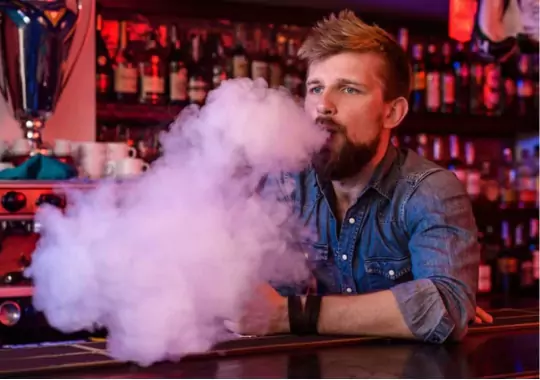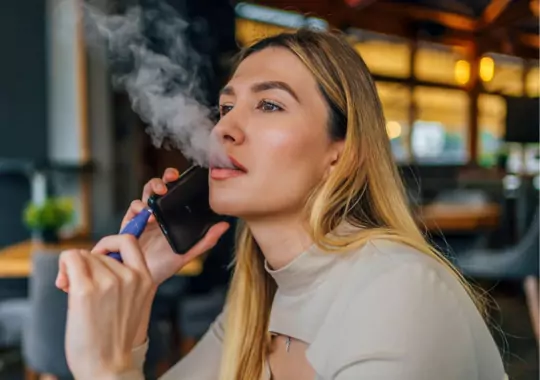As Amazon affiliates we may earn a commission if you purchase a product at no cost to you.
In a recent YouTube video, vape enthusiast and advocate for harm reduction, Jordy Vape Man, delved into the topic of vape safety. Addressing the question What is the Safest Vape for Your Lungs and e-liquids, Jordy explained that vaping, at its core, involves heating vape juice to produce water vapor, which is then inhaled and exhaled.
Understanding Vape Safety
Understanding vape safety requires a comprehensive assessment of multiple factors that contribute to the overall safety of vaping devices.
Device Quality:
The quality of the vaping device plays a crucial role in ensuring safety. Cheaply made or poorly designed devices may pose risks such as battery explosions or malfunctioning heating elements. It's essential to choose devices from reputable manufacturers that adhere to safety standards and undergo rigorous testing.
Vape Juice Ingredients: Another critical aspect of vape safety is the composition of the vape juice. High-quality vape juices typically contain a combination of propylene glycol, vegetable glycerin, flavorings, and nicotine (if desired). However, some low-quality or counterfeit vape juices may contain harmful additives or contaminants, which can pose serious health risks when inhaled. Users should opt for vape juices from trusted brands that disclose their ingredients and undergo testing for purity and safety.
User Behavior: The behavior of the vaper also significantly impacts safety. Proper usage of the device, such as following manufacturer guidelines for charging and maintenance, can help prevent accidents like battery explosions. Additionally, responsible vaping practices, such as avoiding chain vaping (repeatedly puffing on the device without pause) and using appropriate nicotine concentrations, can minimize health risks associated with vaping.
While vaping eliminates many of the harmful chemicals found in traditional cigarettes , it's crucial to acknowledge that inhaling anything other than clean air can still pose risks to respiratory health. Vaping introduces aerosols and potentially harmful substances into the lungs, which may have long-term effects that are not yet fully understood. Therefore, while vaping may be a less harmful alternative to smoking for adult smokers looking to quit, it's not without its own set of risks.

Risks Associated with Nicotine
Nicotine, a highly addictive stimulant found in many vape juices, poses significant health risks, especially when consumed in high concentrations. While nicotine itself is not inherently harmful, its addictive nature and physiological effects can lead to adverse health outcomes, particularly in vulnerable populations.
Elevated Blood Pressure and Cardiovascular Issues: One of the primary concerns associated with nicotine consumption is its impact on cardiovascular health. Nicotine can stimulate the release of adrenaline, leading to an increase in heart rate and blood pressure. Prolonged exposure to nicotine, especially in high concentrations, can contribute to the development of cardiovascular issues such as hypertension, increased risk of heart disease, and stroke. Individuals with pre-existing cardiovascular conditions are particularly susceptible to these risks and should exercise caution when using nicotine-containing vape products.
Addictive Potential:
Nicotine is highly addictive, and regular use can lead to dependence and withdrawal symptoms upon cessation. Vaping devices that deliver high doses of nicotine, such as disposable vapes with high nicotine strengths, increase the risk of addiction, especially among younger users. The addictive nature of nicotine underscores the importance of being mindful of nicotine intake and opting for lower concentrations to mitigate the potential for dependency and associated health risks.
Impact on Adolescent Brain Development: Adolescents and young adults are particularly vulnerable to the harmful effects of nicotine due to ongoing brain development. Nicotine exposure during this critical period can disrupt cognitive function, impair impulse control, and increase the risk of developing nicotine addiction later in life. Therefore, efforts to prevent youth initiation of vaping and reduce access to nicotine-containing products are essential for protecting adolescent health and well-being.
Responsible Vaping Practices
Responsible vaping practices are essential for minimizing potential health risks associated with vaping and promoting long-term well-being. Adopting mindful behaviors and making informed choices can help individuals mitigate the adverse effects of vaping, particularly concerning nicotine consumption and usage patterns.
Avoiding Excessive Use: One of the fundamental principles of responsible vaping is avoiding excessive use of vaping devices. Prolonged or frequent vaping sessions, especially among younger users, can increase the risk of nicotine addiction, adverse cardiovascular effects, and other health complications. Setting limits on vaping frequency and duration can help individuals maintain control over their nicotine intake and reduce the likelihood of developing harmful habits.
Awareness of Health Impact: Understanding the potential impact of vaping on one's health is essential for making informed decisions. While vaping is often promoted as a safer alternative to smoking, it is not risk-free, particularly concerning nicotine consumption. Educating oneself about the potential risks and benefits of vaping, as well as staying informed about emerging research findings, empowers individuals to make healthier choices regarding their vaping habits.
Reducing Nicotine Dependency: For individuals who use vaping as a smoking cessation aid, actively working towards reducing nicotine dependency is crucial for long-term well-being. Gradually tapering nicotine intake through the use of lower nicotine concentrations or nicotine-free vape juices can help individuals wean themselves off nicotine and ultimately quit vaping altogether. Setting realistic goals and seeking support from healthcare professionals or smoking cessation programs can facilitate the process of nicotine dependency reduction and promote successful quitting outcomes.
Limiting Access to Minors: Responsible vaping practices also involve efforts to prevent underage vaping and limit access to vaping products among minors. Younger individuals are more susceptible to the adverse effects of nicotine and may be at greater risk of developing nicotine addiction and other health complications. Implementing strict regulations on the sale and marketing of vaping products, as well as educating parents, educators, and healthcare providers about the risks of underage vaping, can help protect youth from the harms associated with vaping.
In summary, promoting responsible vaping practices involves avoiding excessive use, raising awareness of the health impact of vaping, actively working towards reducing nicotine dependency, and limiting access to vaping products among minors. By adopting mindful behaviors and making informed choices, individuals can minimize potential health risks associated with vaping and promote long-term well-being.
Vaping as a Smoking Cessation Tool
Vaping has emerged as a promising smoking cessation aid for individuals seeking to quit traditional cigarette smoking. While acknowledging that vaping is not entirely risk-free, it can effectively support smokers in their journey towards quitting by providing a less harmful alternative to combustible tobacco products.
Gradual Nicotine Reduction: One of the primary advantages of vaping as a smoking cessation tool is its ability to facilitate gradual nicotine reduction. Vapers can choose vape juices with varying nicotine concentrations, allowing them to taper their nicotine intake over time. By starting with higher nicotine concentrations and gradually transitioning to lower ones, users can gradually wean themselves off nicotine and reduce their dependence on the substance.
Transitioning Away from Combustible Tobacco: Vaping provides smokers with a viable alternative to traditional cigarettes, allowing them to satisfy their nicotine cravings without the harmful effects of combustion and smoke inhalation. Unlike smoking, which involves the combustion of tobacco and the inhalation of numerous toxic chemicals, vaping heats e-liquids to produce aerosols that are significantly less harmful to the respiratory system. This transition away from combustible tobacco can lead to significant improvements in respiratory health and overall well-being.
Temporary Aid, Not Permanent Replacement: It's essential to approach vaping as a temporary aid in smoking cessation rather than a permanent replacement for smoking. While vaping may help individuals quit smoking by providing a less harmful alternative, the ultimate goal should be to eliminate nicotine dependence altogether. Vapers should view vaping as a stepping stone towards achieving nicotine abstinence and prioritize efforts to gradually reduce their nicotine intake until they can quit vaping altogether.
Comprehensive Support and Guidance: Quitting smoking and transitioning to vaping require comprehensive support and guidance. Healthcare professionals, smoking cessation programs, and support groups can provide valuable resources and assistance to individuals seeking to quit smoking through vaping. These resources can offer personalized cessation plans, counseling services, and ongoing support to help individuals navigate the challenges of nicotine withdrawal and achieve long-term success in quitting smoking.
Vaping can serve as a valuable tool for smoking cessation by facilitating gradual nicotine reduction, transitioning away from combustible tobacco products, and providing a less harmful alternative to smoking. However, it's essential to approach vaping as a temporary aid in smoking cessation and prioritize efforts to eliminate nicotine dependence altogether. With comprehensive support and guidance, individuals can successfully quit smoking and improve their overall health and well-being through vaping cessation programs.

Promoting Public Awareness
Educating the public about the potential risks and benefits of vaping is vital for informed decision-making. By disseminating accurate information and dispelling misconceptions, individuals can make healthier choices regarding their smoking habits. Public health campaigns aimed at raising awareness about the dangers of nicotine addiction and the effectiveness of smoking cessation methods, including vaping, can empower individuals to take control of their health.
While vaping offers a less harmful alternative to smoking cigarettes, it is not without its own set of risks, primarily stemming from nicotine consumption. By adopting responsible vaping practices, utilizing vaping as a tool for smoking cessation, and promoting public awareness, individuals can mitigate these risks and work towards achieving better respiratory health.
Recommended Article

Frequently Asked Questions FAQs
Can vaping cause lung cancer?
While vaping is generally considered less harmful than smoking traditional cigarettes, it's not entirely risk-free. Long-term studies on the potential cancer risks of vaping are still ongoing. However, it's important to note that vaping does not involve the combustion of tobacco, which is a primary cause of lung cancer in smokers.
Is it safer to vape than to smoke?
Vaping is often considered a safer alternative to smoking because it doesn't produce tar and many of the harmful chemicals found in tobacco smoke. However, it's not entirely risk-free, and the long-term effects of vaping are still being studied. If you're a non-smoker or former smoker, it's best to avoid vaping altogether.
Are there age restrictions for vaping?
Yes, there are age restrictions for vaping in most countries. In the United States, for example, the legal age to purchase and use vape products is 21. It's essential to adhere to these age restrictions to prevent underage vaping.
Conclusion
Jordy Vape Man's insights underscore that while vaping carries risks, it can serve as a valuable harm reduction tool for individuals seeking to quit smoking. Like any substance, moderation and informed usage are crucial to mitigate potential health hazards. Understanding the risks and benefits of vaping can empower individuals to make informed decisions about their health and smoking cessation journey.










